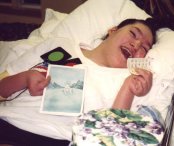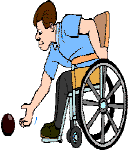The Cerebral Palsy Network
- Spasticity Chart
- Team Approach
- Oral Medications
- ITB
- Rhizotomy
- Orthopedic Surgery
- Brain Injuries
- Casts & Braces
- Physical Therapy
- Glossary Terms
- Credits
- Botox
Around CPN
Resource
Center
-
Botox therapy
Overview
Botulinum toxin injections -- commonly known as Botox therapy -- have become a very useful tool in the treatment of a number of neurological disorders. Botulinum toxin is a protein substance that is directly injected into muscle tissue in order to stop abnormal muscular contraction. It was first used and approved over ten years ago to treat strabismus (misalignment of the eyes). Since then, it has proven effective at treating blepharospasm and hemifacial spasm. It can also provide relief for a number of other neurological disorders characterized by abnormal muscle contraction, including spasmodic torticollis, oromandibular dystonia, and spasmodic dyphonia. Ongoing clinical trials continue to find new uses of Botulinum toxin, as well as a better understanding of its potential complications and contraindications (factors that make a procedure inadvisable).
What is Botulinum toxin?
Botulinum toxin is a protein that is produced by the anaerobic bacterium
Clostridium Botulinum. C. Botulinum was once known only as the culprit of
the often fatal food poisoning known as botulism, which can result from
eating improperly canned foods. The bacteria causes muscle paralysis by
blocking the presynaptic release of the neurotransmitter acetylcholine.
Normally, acetylcholine plays a vital role in sending messages from the
nerves to the muscles that "tell" the muscles to move. The area
where the nerve meets the muscle is called the synapse, and
"presynaptic release" refers to the secretion of acetylcholine
by the nerve cell. When the synaptic transmission is blocked, the muscle
to which that nerve is attached becomes paralyzed.
What
is Botox therapy? There are as many as seven
different types of Botulinum neurotoxin, but only type A is in clinical
use at this time. It is one of the most potent neurotoxins and, indeed,
one of the deadliest substances to humans. Administered safely in small
amounts, however, its therapeutic advantages have proven very promising.
In patients suffering from any of a number of neurological disorders that
lead to uncontrollable muscle spasm and contraction, the Botulinum
neurotoxin can provide relief for anywhere from 6 weeks up to many months.
Over time, it appears that neurons "resprout" from the paralyzed
nerve ending terminals, providing new avenues of communication with the
muscle. After the neurons resprout, the muscle returns to its previously
abnormal state of constant spasm.
Because of the neurons’
ability to "resprout" and re-establish communication between the
nerve and muscle, Botox therapy is only a short-term fix. It needs to be
readministered regularly. Unfortunately, the long-term effects (greater
than 5 years) of receiving regular injections are not known at this time.
Nor has its safety been determined for pregnant women, women who are
breastfeeding, or children who receive chronic therapy.
Following the injections,
patients generally receive some form of physical or occupational therapy,
which involves stretching the muscle to lengthen the tissue and improve
its function.
Even very small amounts of
the toxin can, however, have undesirable side effects. The main side
effect is weakness in the group of muscles that is being treated. Drooping
of the eyelids (ptosis) for example, can develop when blepharospasm is
treated. Muscular weakness is often short-lived though. Some patients
develop flu-like symptoms, but this is relatively rare.
Strabismus
- is a misalignment of
the eyes; the eyes appear to be looking in different directions. There are
several different types of strabismus, which is usually treated
surgically. Botulinum toxin can be an effective alternative to surgery for
many patients, although studies comparing botox therapy and surgery have
not been done.
Miscellaneous other
conditions
Botox therapy is the direct injection of the Botulinum toxin into a
specific muscle, with the aim of blocking the transfer of acetylcholine
and, in so doing, alleviating muscle spasm due to too much neural
activity.
Despite any alarm triggered by the word "botulism," the Botulinum
toxin is a safe and effective agent when used appropriately by physicians
who are professionally trained to use it. The doses required are tiny
amounts, which are very carefully injected into specific muscles.
Botulinum toxin is accepted treatment for a number of neurological and
ophthalmisc (eye) conditions. These include strabismus, blepharospasm,
hemifacial spasm, spasmodic torticollis, oromandibular dystonia, and
spasmodic dyphonia.
Preliminary reports on a variety of other conditions suggest that Botulinum
toxin therapy may be an effective treatment. Stuttering (speech
characterized by repetitions of sounds and words) and vocal tremor (speech
characterized by quavering), for example, may be treatable with Botulinum
toxin. Botulinum toxin has also been used successfully for specific types
of urinary incontinence.
Credit for this report goes to the Neurology Forum. Thankyou for your efforts to provide this information to others.
This site designed & maintained by Mystic Dawn Web Creations. The Cerebral Palsy Network©1997/2003. All graphics are the exclusive property of CPN, unless otherwise indicated. Contact CPN at Cerebral Palsy Network for further information.
Last updated 03/24/03

Amanda the reason CPN was
started
CPN
Reunion 2003

CP
Research
What's happening Today with
Cerebral Palsy

Special
Olympics
What's happening with
Special Olympics in 2003

CP
& Education
What's happening with
Special Need and Education in 2003